Postcards From Tower Hamlets Town Hall
by Louise Rondel & Eleanor Smith-Hahn
16 January 2024


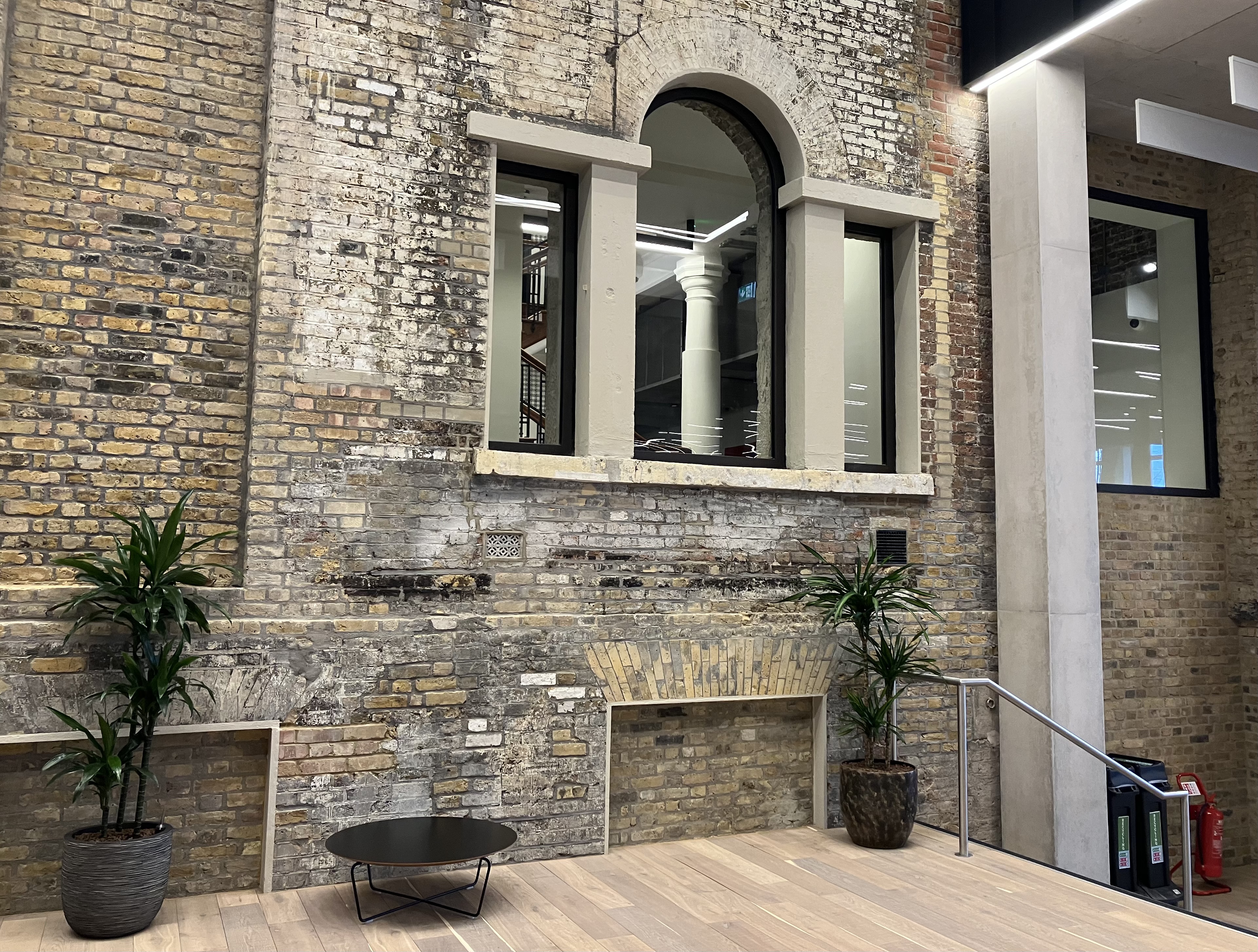
In the new series Building Civic Space co-curated by Eleanor Smith-Hahn and Louise Rondel, we are inviting participants to spend time together in different public buildings to explore the relationship between these places and the civic life that ‘happens’ there. During the first event, a group of researchers and students from the CUCR visited the Tower Hamlets Town Hall where we were taken on a guided tour of the new building. The former Royal London Hospital in Whitechapel has been converted into the borough’s town hall. The building houses a range of resident services and the council’s offices. Council meetings, which the public can attend, are held here and there is a cafe and public seating area.
We focused on the interconnections between architecture, place-making and civic life as we walked around the building with our guides. As a group of sociologists, we considered: what atmospheres and moods are created by the building? What is the relationship between the architecture and what happens here? And who can access the space and on what terms?
In this Postcard from Tower Hamlets Town Hall, we offer our reflections and images in response to these questions.
With thanks to our tour guides for facilitating the visit and sharing their knowledge and insights.
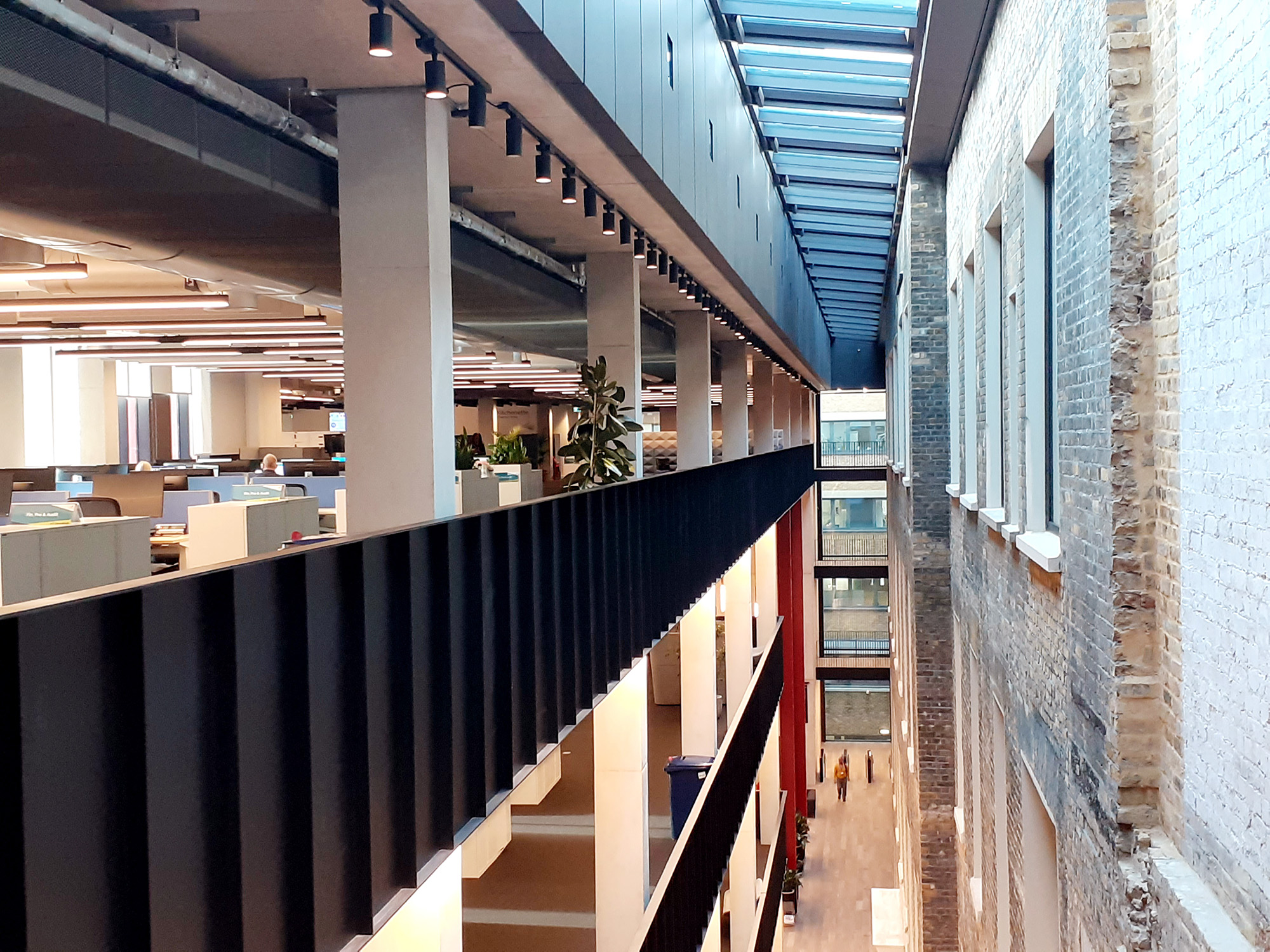
For me, the new Tower Hamlets Town Hall is an example of when the combination of conservation, retrofit and new build really works, at least from an aesthetic perspective. I found the earthen colour palette created through brick, wood, concrete, steel, original terrazzo floor tiles and green plants everywhere, together with lots of soft daylight coming in from the rear, really calming. Overall, the visual effect was very pleasing to the eye. There was a lot of empty space on the ground floor, allowing us to spend time there and admire details but I would also like to see these spaces being used by staff and the public. The experience of the building was enhanced by our tour guide’s passionate account of the history of the building and the remaking of it, his personal and collective memories of the building being a hospital, and his anecdotes and knowledge of various spaces, with the old surgical ward and its former operating theatres turned into meeting and break-out rooms, and the wooden “heritage staircases” being among the favourites. It would be an interesting research project to see how other people living in the area experience the building. For me, the building has a very welcoming feel and I could imagine spending more time in the spaces open to the public, writing, talking, having a coffee. I would find it harder to work in the open-plan offices with their hot-desking approach, constant artificial lighting and reverberating noises, but thankfully I don’t have to think about that.
Anita Strasser
 image : Zoe Walshe
image : Zoe WalsheDear Nan,
Today, I was in Whitechapel visiting the old building of the Royal London Hospital. How funny that work led me back to where you were born. Naturally, I thought of you! The research centre I'm part of is running a seminar series called Building Civic Space, where we visit and explore public spaces, a bit like a fieldtrip. Our first stop was Tower Hamlets Town Hall. It is years since the Royal London Hospital fully moved into the bigger modern buildings (right behind the old one). And, the council has now done a big renovation of the historic hospital building, turning it into the new town hall. Sharp new modern design (floor to ceiling windows, exposed steel) slots together with historic elements that have been preserved. The old yellow stock brick walls remain, the original wooden staircases up to what was the surgery ward and the terrazzo flooring that runs the length of that corridor. A reminder of how practical and long-lasting high-quality materials are...that floor looks fantastic even after so many years. One meeting room is even adorned with assorted surgery equipment, gathered from across the old operating theatres.
After the renovation, the council invited nurses who worked at the hospital to come and see the building. The preserved parts were, of course, familiar favourites; eliciting stories and memories from their years of working, of caring, of watching over patients within those walls. Some nurses shared tales of haunting. The ghostly nurse who would tap on your shoulder if you were starting to nod off on night shift. Another, a ghostly sister, who gave instructions to check bed eleven, even though the nurse on shift had just done her round (an instruction which saved a life, according to the story). My colleague Rachel - who is both a practising nurse and a sociologist (!) – told me that hospital stories of haunting are almost a genre in themself. I guess that makes sense for places and people who deal not only with life, but also death on an everyday basis.
Forgive me for heading down that rabbit hole of hauntings, of how buildings hold stories. For all my talk of history and hauntings, the past isn’t the main feel of this place at all. It is a working building. Council staff working in teams across big open plan offices on the upper floors, and locals waiting on sofas in the ‘residents’ hub’ to sort out their housing or other services. The town hall’s ground floor is open, with plenty of space to sit and a cafe to have a cuppa. Tonight, a full council meeting is scheduled, so members of the public can attend (with a ticket), petitions can be raised (via certain procedures) and so on. The council chamber has a glass wall onto the main atrium – transparent. The historic building front makes an effectively symbolic backdrop for local protests. I left thinking about how the business of local democracy is staged here, alongside the practical business of sorting out living and residing in the borough. True of town halls up and down the country. But this visit got me thinking about how our town halls – as civic spaces - weave together the functional, bureaucratic and symbolic in one building. And how local histories materialise in the buildings themselves.
Here are a few photos. I’ll let you know where we head next.
Love,
Zoe
Zoe Walshe
 image : Jeonghan Yoon
image : Jeonghan YoonAs a person who can exist in this city only with permission from the public authority, public buildings are always intimidating urban infrastructure, because usually nothing positive happens when I enter there. Although I was checked by the security at the entrance for no reason, the overall experience at Tower Hamlets Town Hall was more welcoming and intimate than I expected. I’m not sure how many people know that building is usable by themselves, but anyway I hope more local people come, occupy and enjoy the space which is actually theirs. At a time when more urban space is privatised and thus closed to the inhabitants, and less profitable urban heritages are overlooked by private agencies, the town hall was a decent example of how public bodies should use and operate contemporary cities.
Jeonghan Yoon
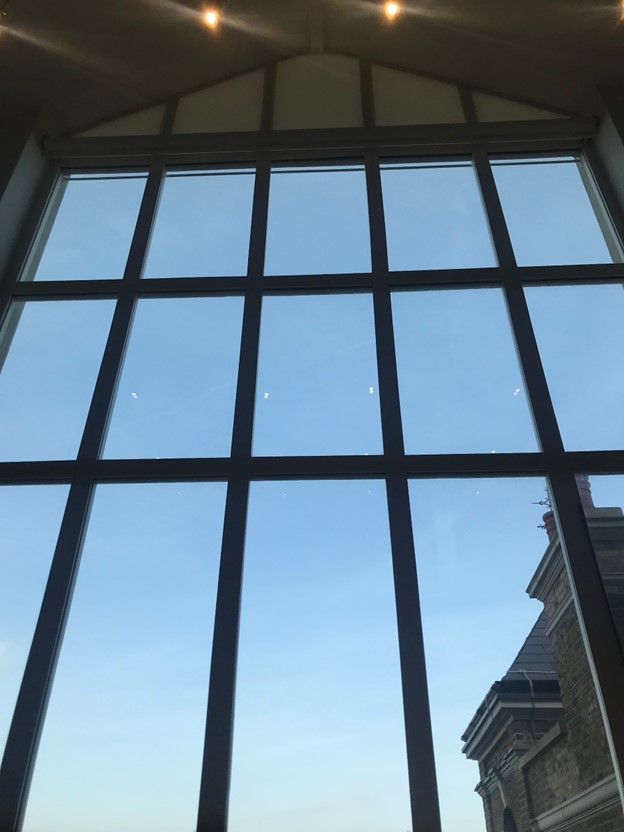
Access to and connection with the building are recurrent themes on the tour. Including geographic access. The new Town Hall is at the centre of the borough, opposite the train station, easier to get to than the previous building for residents and the people who work there alike. In this way, it is physically as well as symbolically connected to the life of the borough. There are also emotional connections with the space which are drawn out during our visit. A former hospital, our tour guide tells us he remembers being patched up here as a kid after falling off a wall or a roof during some adventurous escapade. It is a place where the borough’s residents have been born, been ill, made well and died. In some ways it is haunted. The fabric of the building holds and maintains these attachments. In addition to these long-standing emotional resonances, new connections are being made. From the sixth floor, you can look out over the borough and, at the right angle, you can see the West Ham ground (just don’t mention that you can also see The Den when you look south!).
Louise Rondel
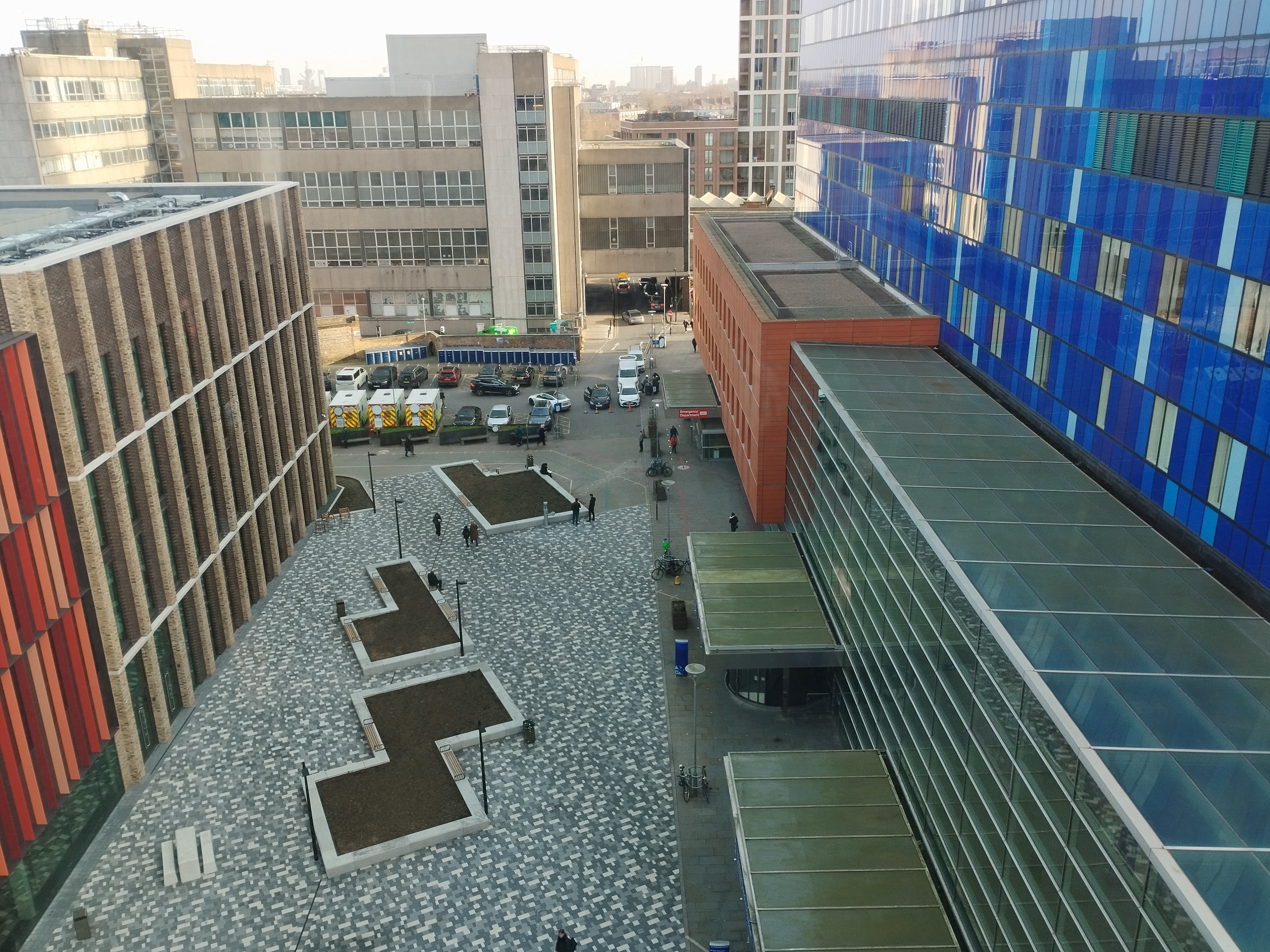
Outside the town hall, the street is bustling, someone is chanting, maybe this is a street concert? No, a man is preaching into a microphone. I go through the first automatic doors, see both security guards at the entrance, look at them, look forwards, look back at them again - should I slow down, do they want to check my bag? They look away, apparently, they are not going to control me or my ID. A little surprised, I go through yet another automatic door, and am met by a big hall, a round welcome desk, a very high ceiling drowning voices. Over there at the back there is the café - it is the first time I see a café in a town hall! They serve potatoes with melted cheese - is this a British specialty? We go through the building following both our guides who lead us through this large open space and its multiple floors. The old hospital moved into the building across from the town hall, a great blue building - both sites remain linked together by a shared public space where our guide tells us that nurses and civil servants mix on sunny lunch breaks. The architecture portrays openness and transparency, the new town hall is now more central than the old one used to be, and it is on its steps that the borough’s residents shop, demonstrate, feel they can be heard, that the space is reclaimed also for civil and political life - because it is already growing to become their town hall.
Myrtille Picaud

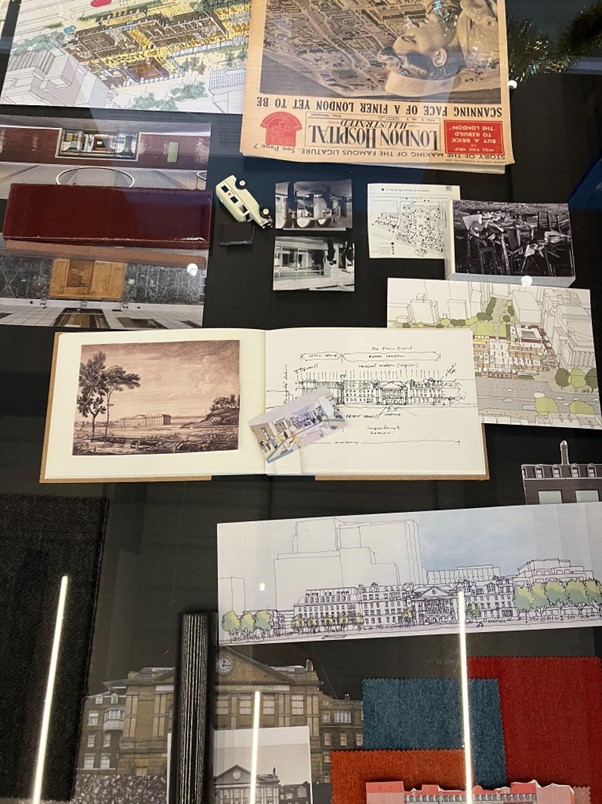
images : Raquel Figueira
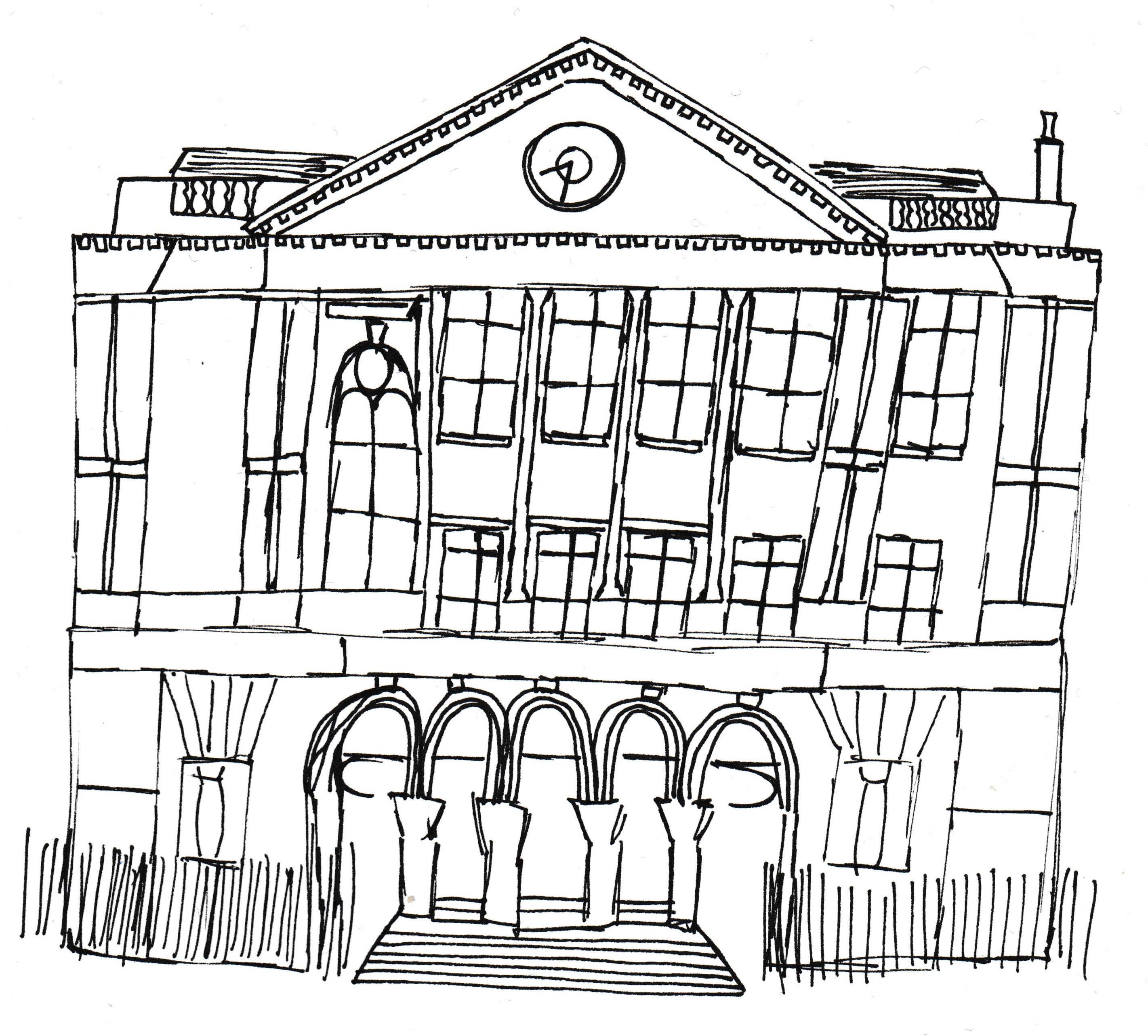 image : Eleanor Smith-Hahn
image : Eleanor Smith-HahnThe ordinary visitor has a specific purpose in going to the town hall. I experience the Tower Hamlets Town Hall building as a montage of different parts. It is a site of local bureaucracy, decision-making and political and cultural expression. On the guided tour we travel through the public and private areas as a contained bubble. I want to pay attention to the everyday life of this civic building. I am curious about what happens here.
We enter Tower Hamlets Town Hall. Inside the entrance is the Residents’ Hub, where people can access several services, such as Council Tax, Welfare Benefits and Domestic Abuse. Our guide notes that people also come in for appointments with drugs and alcohol, homelessness and youth services, and there is support for ex-convicts. On the ground floor, the impressive, open-plan expanse has distinct zones. There is a seating area for council staff and a separate seating area for visitors. There are several ways of interacting with the space. An exhibition and event space overlooks Whitechapel Road. There is a café serving simple food. The council chamber, observable through a glass window, descends from the ground floor. There is a small auditorium of red seats. Council meetings taking place in the chamber can be attended by up to 90 members of the public. This requires a time investment and pre-planning for people who want to attend, with tickets being offered from 5pm for a 7pm start.
The Town Hall encourages multiple forms of public participation. For example, by urging the public to submit a petition or contact their councillor. As Zoe notes above, the building’s iconic façade provides a powerful forum for local protests. Demonstration is also part of the quotidian life of the building’s interior, with council meetings sometimes being interrupted by members of the public audience.
Tower Hamlets Town Hall is fluid and multi-levelled with a clear range of functions. On the upper floors, we see the building as a workplace for council staff. Large offices are filled with rows of desks and computers. They overlook London’s vistas through glass exterior walls. Council staff working on computers are talking; they sit in labelled zones based on their department. We learn that in the previous town hall building, council departments were siloed on different sides of the building. The new town hall brings staff together, with the hope of fostering good communication and teamwork among departments. We are shown a staff cafeteria, historic meeting room, break room (where yoga and Zumba classes are held) and an outdoor patio.
Struck by the building’s spatial division between staff and visitors, I ask if there are any meeting rooms for public consultations above the ground floor. We learn that consultations take place at sites in the borough near to residents’ homes so that they are accessible. This feels like a diffusion of the town hall, or creation of satellite sites, which serve neighbourhoods directly, but also risks separating the public from the council. The iconic town hall building appears as the centre of a more scattered geography for the council’s work. There are Residents’ Hubs throughout the borough, where council services can be accessed. I am interested that the town hall meetings can be attended and participated in online. Extending the building’s inclusivity and spatial remit.
I am keen to visit more civic spaces as a point of comparison. I’d like to experience the everyday life of a range of public buildings.
Eleanor Smith-Hahn
If you would like to participate in future events in the Building Civic Space series, please contact Eleanor and Louise esmit055@gold.ac.uk and l.rondel@gold.ac.uk
Eleanor Smith-Hahn is a CUCR member and doctoral researcher in the Goldsmiths Sociology Department.
Dr Louise Rondel is a Visiting Researcher and Knowledge Exchange Fellow at the CUCR.
︎ Background image : Anita Strasser

